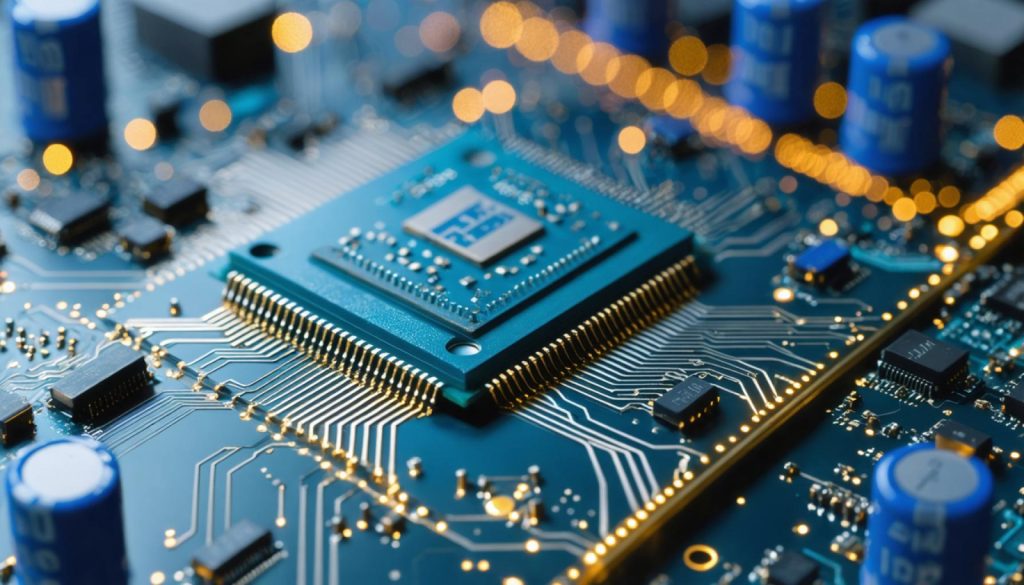
- TSMC unveiled the groundbreaking 2nm chip on April 1, 2025, signifying a major advancement in semiconductor technology.
- This new chip offers a notable performance boost—10%-15% faster—or reduces power consumption by 20%-30% compared to its 3nm predecessor.
- The increased transistor density, up by 15%, enhances both efficiency and processing power, promising widespread benefits for computing devices.
- The 2nm chip is poised to revolutionize various devices, including smartphones, laptops, and AI applications, with improved performance and sustainability.
- Key industries such as autonomous vehicles, robotics, and data centers could experience significant advancements due to this technology.
- Despite its potential, challenges remain, including the need for EUV lithography and addressing heat dissipation to maintain performance.
- TSMC’s innovation aligns with global sustainability goals, working towards greener technology solutions for a digitally enhanced future.
On the vibrant tapestry of technology, a new thread has been woven. On April 1, 2025, Taiwan Semiconductor Manufacturing Company (TSMC) unfurled the 2-nanometer (2nm) chip, marking a momentous leap in semiconductor technology. This marvel of microengineering, poised to reshape the contours of our digital landscape, promises unrivaled performance and efficiency, capturing the imaginations of tech enthusiasts and industry leaders alike.
Imagine the world of electronics: a symphony of tiny circuits pulsing within almost every modern device. The heartbeat of these systems is the microchip, an intricate labyrinth of transistors. Each transistor acts as a microscopic switch, orchestrating the dance of electricity with exponential prowess. As chips shrink, they harbor more transistors in a diminutive area, ushering in an era of speed and power without precedent.
TSMC’s 2nm chip, a paragon of innovation, offers significant enhancements over its predecessor, the 3nm chip. It unveils a tantalizing 10%-15% speed boost or a compelling 20%-30% reduction in power consumption, harnessing the alchemy of silicon to yield unprecedented efficiency. The increase in transistor density by a remarkable 15% further fuels this technological renaissance.
The true genius of the 2nm chip lies in its transformative potential for the devices it inhabits. Envision smartphones with a lifespan akin to the most enduring novels, laptops that eclipse boundaries of capability, and tablets as light as feathers yet potent as ever. The omnipresent reach of AI stands to benefit immensely; from savvy voice assistants to fleetingly precise real-time translations, the possibilities stretch as far as the imagination can see.
Industries at the forefront of technological evolution—such as autonomous vehicles, robotics, and data centers—stand to gain colossal benefits. The decreasingly light energy footprint of 2nm chips aligns seamlessly with global sustainability goals, potentially carving pathways to greener data centers and smarter machines.
Yet, the road to innovation is punctuated by challenges. The intricate craft of producing 2nm chips demands extreme ultraviolet (EUV) lithography—a meticulous and costly endeavor. The battle against heat looms large; maintaining the delicate balance of thermal dissipation is pivotal to preserving chip performance and longevity. Conventional materials, like silicon, might reach their zenith, heralding a push towards novel substrates.
In this intricate dance of micro scale discovery, TSMC’s 2nm chip emerges as a potential key to a future where technological prowess meets sustainability, powering a myriad of devices that are not only smarter but also kinder to our planet. This seminal advancement charts a course toward a new era of computing: one where the synergy of power, efficiency, and elegance paves the way for a digitally enriched existence.
Discover the Game-Changing Impact of TSMC’s 2nm Chip Technology
The Unprecedented Leap in Semiconductor Technology
The unveiling of TSMC’s 2-nanometer chip on April 1, 2025, marks a groundbreaking advancement in the semiconductor industry. This innovation highlights a new epoch of computing power and efficiency, offering substantial improvements over the widely used 3nm chips. Let’s explore additional insights, potential applications, and the opportunities and challenges that accompany this technological marvel.
Key Advancements and Specifications
1. Enhanced Performance and Efficiency:
– The 2nm chip provides a 10-15% increase in processing speed.
– It reduces power consumption by 20-30%, critically important for battery-powered devices.
2. Increased Transistor Density:
– The chip boasts a 15% rise in transistor density, leading to better performance and lower energy requirements.
3. EUV Lithography:
– Production relies on extreme ultraviolet (EUV) lithography, allowing for precision manufacturing at a smaller scale.
Real-World Applications and Benefits
1. Consumer Electronics:
– Smartphones & Tablets: Expect longer battery life and faster processing, allowing for enhanced user experiences with richer applications and seamless multitasking.
– Laptops: Increased computational power supports more robust software, catering to professionals and gamers alike.
2. Automotive and Robotics:
– Autonomous Vehicles: Improved processing speed and power efficiency are vital for real-time data analysis and decision-making, enhancing safety and reliability.
– Robotics: More efficient chips allow robots to perform complex tasks with greater precision and efficiency.
3. Data Centers:
– The energy efficiency of 2nm chips can lead to greener data centers, aligning with sustainability goals by reducing carbon footprints and operational costs.
Challenges and Considerations
1. Heat Dissipation:
– Addressing thermal challenges remains critical to maintaining chip performance and longevity.
2. Material Limitations:
– Conventional silicon substrates may reach their limits, prompting exploration of alternative materials like graphene or other semiconducting compounds.
3. Production Costs:
– The cost of EUV lithography is high, potentially affecting the pricing and availability of 2nm-based devices.
Market Forecasts and Industry Trends
The 2nm technology is expected to dominate the semiconductor market over the next decade. As industries adopt this cutting-edge technology, we anticipate:
– Increased Demand: The drive for faster and more efficient devices will propel the demand for 2nm chips.
– Innovation Surge: Companies will invest more in research and development to harness the full potential of these chips in AI and machine learning applications.
Security and Sustainability
The reduced power consumption aligns with global sustainability objectives. Additionally, TSMC’s commitment to secure manufacturing processes ensures the chips remain integral to modern cybersecurity frameworks.
Actionable Recommendations
1. Stay Informed: Keep up with the latest developments in 2nm technology to understand its applications and benefits for both consumers and industry leaders.
2. Explore Upgrades: Businesses should begin assessing the potential advantages of upgrading to 2nm technologies for enhanced operational efficiencies.
3. Invest in Training: Educate workforce and IT teams on managing and integrating 2nm technologies effectively.
Conclusion
TSMC’s 2nm chip is not just a leap forward in technology but a step towards a sustainable and advanced digital future. By addressing potential challenges and capitalizing on its unique advantages, this innovation promises to reshape industries and pave the way for a host of new applications.
For further insights into the semiconductor industry, visit TSMC.
Through understanding and adapting to these breakthroughs, businesses and consumers alike are poised to benefit from the next wave of digital transformation.



